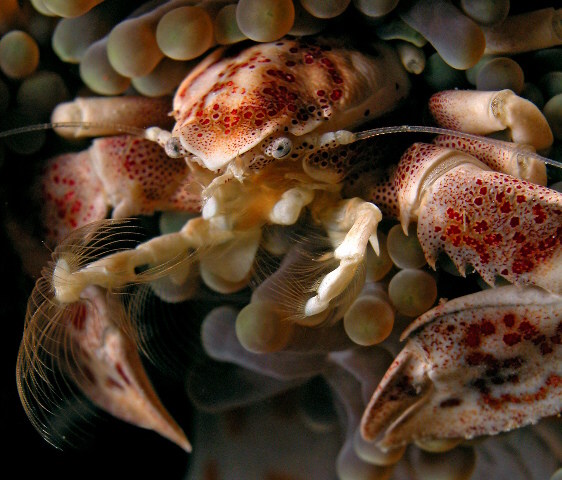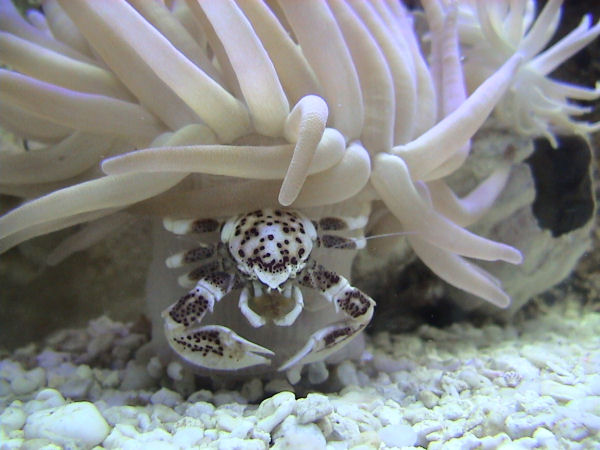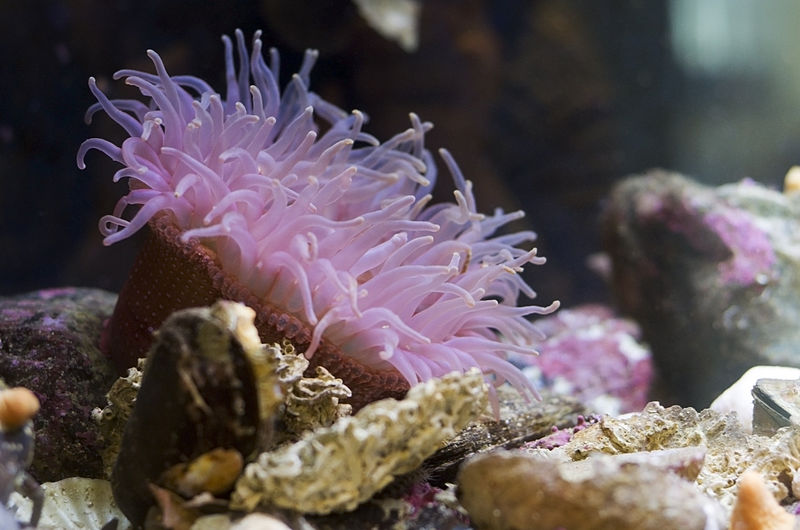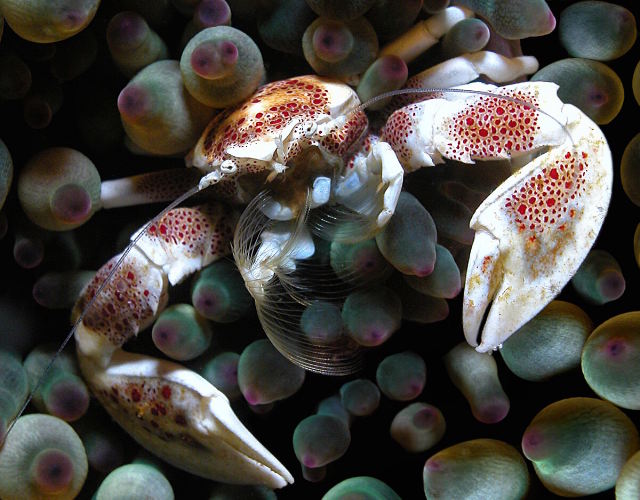Interactions with Others
HOW DOES THE SPOTTED PORCELAIN CRAB INTERACT WITH OTHERS WITHIN THE HABITAT?
Just to recap what you read in the Habitat and Geography section of the web page, the Spotted Porcelain Crab lives in multiple oceans, but is most common near the Philippines in the Pacific Ocean. The zone of the ocean in which it thrives would be the intertidal zone. Within the intertidal zone, the Spotted Porcelain Crab lives with many other species. One in particular is the sea anemone. The sea anemone plays a special role in the Spotted Porcelain Crab's habitat. This unique structure is what the Spotted Porcelain Crab calls home. Believe it or not, the Spotted Porcelain Crab lives essentially unharmed among the tentacles of the sea anemone which are heavily armed with nematocysts (toxins). The toxins in the tentacles are made primarily of peptides and proteins, and also used for prey acquisition. They can also be used to deter potential predators by causing pain, loss of muscular coordination and tissue damage (Mebs, 2009). Predators of the Spotted Porcelain Crab are a vast variety of sea organisms, of which include the tiger shark, white tip reef shark, hammerhead shark, blacktip reef shark, green humphead parrotfish, napoleon wrasse, and the cuttlefish. It would be very bad if these predators came in close contact with the Spotted Porcelain Crab. Luckily, the Spotted Porcelain Crab is able to release positive chemical signals to the sea anemone helping it recognize the Spotted Porcelain Crab and telling it not to sting (Mebs, 2009).
HOW DOES THE SPOTTED PORCELAIN CRAB GET FOOD TO SURVIVE?
Since the Spotted Porcelain Crab is sheltered within the toxic
tentacles of the sea anemone, it uses a mechanism known as filter
feeding to gather its food.
 This
mechanism is extremely beneficial because the Spotted Porcelain Crab
never has to leave the sea anemone. To use the filter feeding
method, the Spotted Porcelain Crab has tiny feathery arm like
structures located right below the head. These feathery arms sweep
through the water column collecting tiny organisms such as
zooplankton, other tiny animals or plants, and even phytoplankton.
After the Spotted Porcelain Crab sweeps through the water to gather
food, it brings the feathery arms to the mouth, where two additional tiny
spoon like structures (bristles) sweep the food off the feathery arms and
push it into the Spotted Porcelain Crab's mouth (British
Broadcasting Corporation, 2010). This behavior is very unique to the
Spotted Porcelain Crab considering that there are roughly 300
species in the family Porcellanidae, many of which, use their front
two pinchers to feed by taking chunks of food off their prey and
consuming it (British Broadcasting Corporation, 2010).
This
mechanism is extremely beneficial because the Spotted Porcelain Crab
never has to leave the sea anemone. To use the filter feeding
method, the Spotted Porcelain Crab has tiny feathery arm like
structures located right below the head. These feathery arms sweep
through the water column collecting tiny organisms such as
zooplankton, other tiny animals or plants, and even phytoplankton.
After the Spotted Porcelain Crab sweeps through the water to gather
food, it brings the feathery arms to the mouth, where two additional tiny
spoon like structures (bristles) sweep the food off the feathery arms and
push it into the Spotted Porcelain Crab's mouth (British
Broadcasting Corporation, 2010). This behavior is very unique to the
Spotted Porcelain Crab considering that there are roughly 300
species in the family Porcellanidae, many of which, use their front
two pinchers to feed by taking chunks of food off their prey and
consuming it (British Broadcasting Corporation, 2010).
Please take a closer look at the images Dave Harasti has granted me with. If you are interested in his line of work and other pictures he has published, check out his page on Scuba Equipment USA - Marine Species Gallery by clicking here and his web page regarding The Underwater Photo Gallery by clicking here.
WHAT TYPE OF SYMBIOSIS DOES THE SPOTTED PORCELAIN CRAB HAVE WITH THE SEA ANEMONE?
Since the Spotted Porcelain Crab and
 the
sea anemone heavily depend on one another to survive, they have what
is called a mutualistic symbiosis. Mutualistic symbiosis (the
interaction between species, where both partners derive benefits) is
a common phenomenon in nature (Mebs, 2009). In this particular
relationship, the Spotted Porcelain Crab is benefitting from the
sea anemone by being protected from potentially harmful predators and it has a place to live. On the other hand, the sea anemone
is benefitting by getting nutrients from the Spotted Porcelain
Crab that it would not normally get by itself. Nutrients such as
ammonia, sulphur and phosphorus are excreted by the Spotted
Porcelain Crab and the sea anemone uses it to benefit itself (Mebs,
2009). The Spotted Porcelain Crab also assists in keeping the sea
anemone free from debris (Shedd Aquarium, 2001).
the
sea anemone heavily depend on one another to survive, they have what
is called a mutualistic symbiosis. Mutualistic symbiosis (the
interaction between species, where both partners derive benefits) is
a common phenomenon in nature (Mebs, 2009). In this particular
relationship, the Spotted Porcelain Crab is benefitting from the
sea anemone by being protected from potentially harmful predators and it has a place to live. On the other hand, the sea anemone
is benefitting by getting nutrients from the Spotted Porcelain
Crab that it would not normally get by itself. Nutrients such as
ammonia, sulphur and phosphorus are excreted by the Spotted
Porcelain Crab and the sea anemone uses it to benefit itself (Mebs,
2009). The Spotted Porcelain Crab also assists in keeping the sea
anemone free from debris (Shedd Aquarium, 2001).
Want to learn more interesting facts about the Spotted Porcelain
Crab? Click
here to
be transferred to the next section containing Additional Facts.
If you would rather return to the home page, click here.


